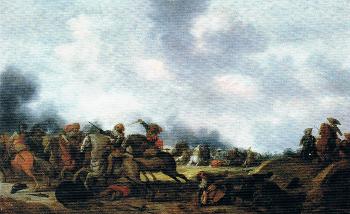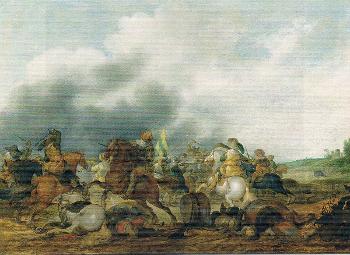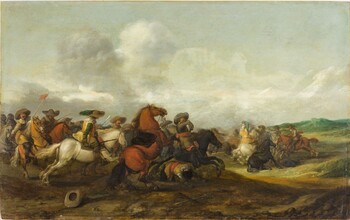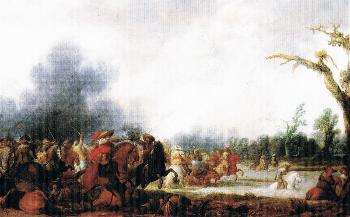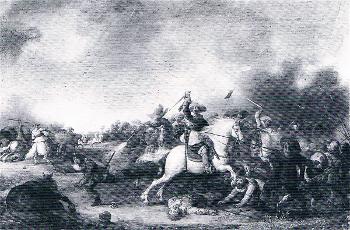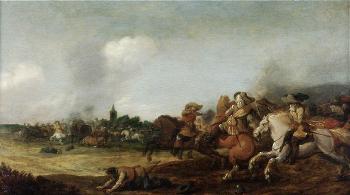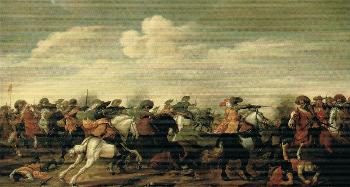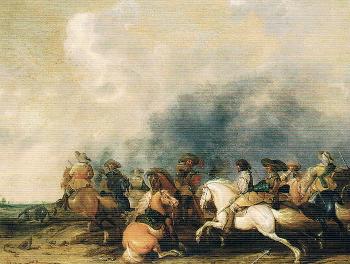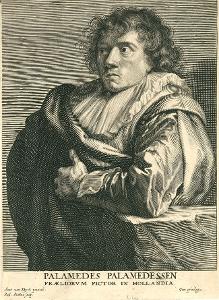Palamedes Palamedesz.I
A cavalry battle scene
Oil on panel : 50,3 X 67,2 cm
Unsigned
Sold at Sotheby’s Amsterdam, 14/11/06
For 14.400 €
This is a comparative item
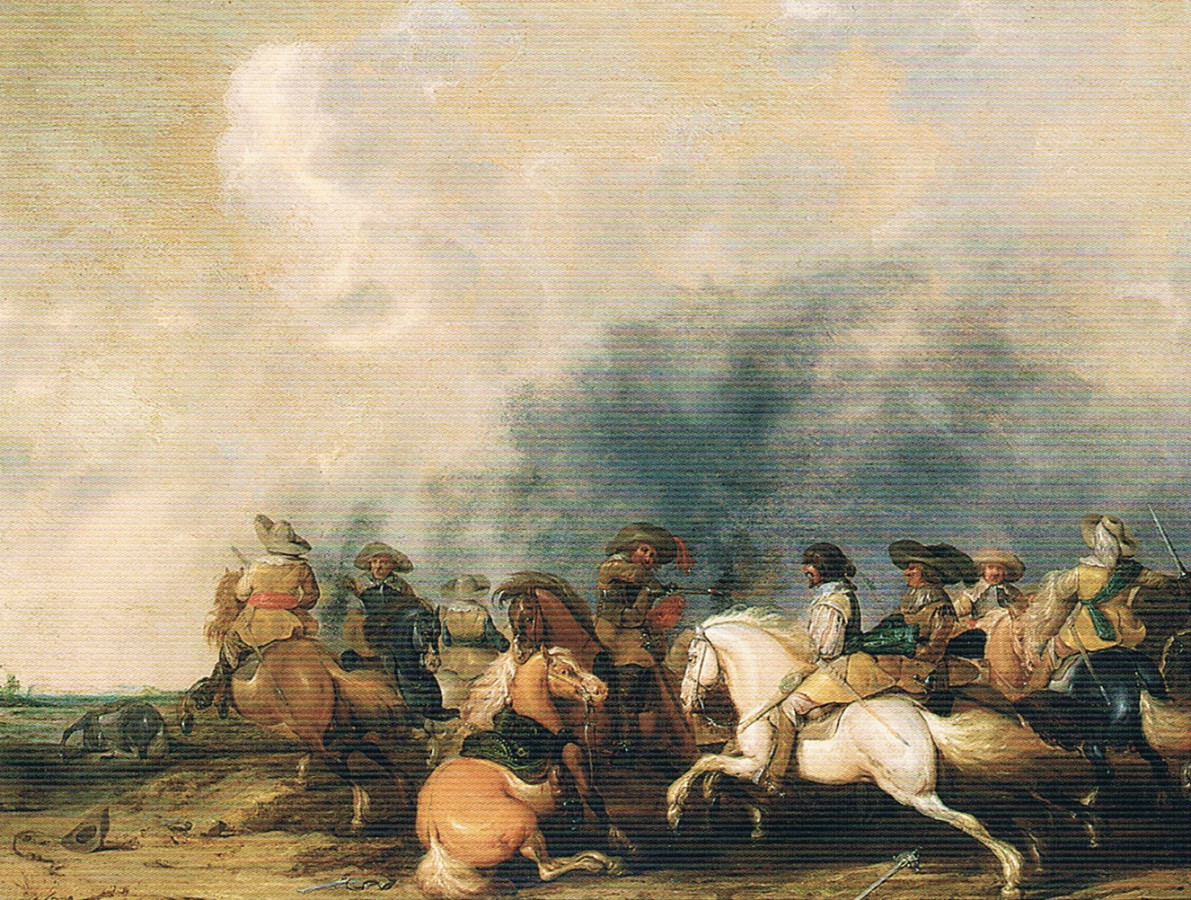
Painting for Sale
Palamedesz., Palamedes I
"A cavalry battle scene"
In short
Palamedes Palamedesz. (pronounce Palamedeszoon) the Elder was an important Dutch battle scene painter, a witness of the Dutch effort to gain independence from Spain. He carried the same first name (Palamedes), last name (Stevaerts) and nickname (Palamedesz.) as his father, who was a gem-cutter.
Our main figure, at the centre of the composition, appears in several other paintings by our painter:
- in a painting from the 1630s (the last digit is illegible) from the Prinsenhof Museum of Delft;
- in an undated painting sold at Sotheby’s Amsterdam, 15/11/05.
As to the rare signature on our painting, he also used it on another cavalry battle scene, from 1631.
About Palamedes Palamedesz. I
Dutch painter
Probably London, possibly Scotland 1607 – 1638 Delft
Battle scene painter.
Younger brother of Anthonie Palamedesz. (Delft 1601 – 1673 Amsterdam), who was a genre and portrait painter; he often painted interior scenes, especially guard room scenes, and is also known as a staffage painter in landscapes and architectural scenes by other painters.
Arnold Houbraken (1660 – 1719) published in 1718 his famous “De groote schouburgh der Nederlantsche konstschilders en schilderessen”, a biography of all important Dutch painters. The major part of his text on Palamedes Palamedesz. he apparently “borrowed” from an earlier book, “Beschryvinge der Stadt Delft” by Dirck Evertsz. van Bleyswijck. This future burgomaster of Delft was only 17 years old when he published in 1667 this description of his hometown and the greatest accomplishments of its citizens.
According to van Bleyswijck Palamedes Stevaert, the father of Anthonie and Palamedes Palamedesz., was a gem-cutter and sculptor from Delft who carved semi-precious stones (jasper, porphyry, agate, etc.) into vases and other decorative art. This father was of Flemish origin; he must have been one of those many Protestants who fled from Flanders and its Spanish Inquisition to Holland.
Van Bleyswijck further tells that our painter, not his elder brother, was born while his father was at the service of King James VI of Scotland (1566 – 1625). Shortly after Palamedes’ birth he returned with his family to Delft. Van Bleyswijck mentions James as king of Scotland (which he actually became at the age of thirteen months in 1567), so it is possible that Palamedes was born in Scotland.
On the other hand we should mention that James VI, this time under the name of James I, became also king of England and Ireland in 1603; in 1607 Palamedes must therefore most probably have been born in London instead of in Edinburgh.
Palamedes Palamedesz. I was strongly influenced by the first Dutch painter of contemporary battle scenes, Esaias van de Velde (Amsterdam 1587 – 1630 The Hague). It is not known if he studied under him. According to Houbraken Palamedes was so talented that he learned painting just by copying paintings of van de Velde.
He became a Master in the Painters’ Guild of Delft in 1627.
As to Anthonie’s teacher he is also unknown, but it has been speculated that he may have studied in Delft with the court painter Michiel van Mierevelt and/or Hendrick Pot, who was in the city in 1620.
Palamedes Palamedesz. I died at the very young age of 31 in 1638.
It is thought he worked during his complete career in Delft, except for the period 1631/32 when he lived in Antwerp. During that period Anthonie van Dijck made an engraving with his portrait. I do not know why he moved to Antwerp one year after his marriage, nor why he left again so rapidly. But in 1632 the chances of war had again shifted. The Dutch Stadtholder Frederick Henry in his famous “March along the Meuse” captured several towns (Venlo, Roermond and Maastricht) as a preparation for the conquest of the more important Flemish towns of Antwerp and Brussels, which he hoped to take the next year. But this was never to happen … due to the lack of enthusiasm of the Flemish. Why? In fact because since the start of the Eighty Years’ War in 1566 sixty four years had passed during which most Protestants had fled Flanders for Holland (and some for Germany). In other words the very large majority of the population of Flanders was Catholic and therefore pro-Spanish. And above all they were fed up with this war.
About the Eighty Years’ War and about the evolution of battle scene painting.
1. The Eighty Years’ War started of as a Protestant uprising in Flanders and in Holland against the Catholic Spanish Habsburg. It ended with the Peace of Westphalia in 1648: Spain recognized an independent Republic of the Seven United Provinces, Holland, while Flanders remained Spanish.
The War can be divided into four phases:
- 1568 until circa 1600 : this period ends with Prince Maurice taking a lot of towns from the Spaniards.
- 1609 – 1621: the Twelve Years’ Truce.
- 1621 – 1625 : important Spanish successes, for example the fall of Breda in 1625.
- 1625 – 1648 : the new stadtholder Frederick Henry takes town after town.
2. Both in the Southern (Flanders) and in the Northern (Holland) Low Countries there was an important market for subjects related to the War: specific sieges (which were rare), unspecified battle scenes, resting soldiers, attacks on travellers and convoys, village plunderings, army camps and guardroom scenes. A lot of specialists were active in every of these specific domains.
Our painting belongs to the unspecified battle scenes. It might seem strange to you but almost all battle scenes have no references to time or place. The painters visualised current events in a general way. As their clients, from nobility and the higher middle classes, belonged to the cavalry (which made out a quarter of the army) they mostly painted cavalry battles, much less engagements between cavalry and infantry.
The best known specialists in cavalry battle scenes were:
- in Flanders Sebastiaen Vrancx, Pieter Snayers and Pieter Meulener;
- in Holland Esaias van de Velde, Palamedes Palamedesz., Jan Martsen de Jonge, Abraham van der Hoeff, Jan Jacobsz. van der Stoffe, Jan Asselijn and Philips Wouwerman.
The simplest difference between both regions is that the Flemish battle scenes painters often use a high horizon line, the Dutch a low one. Exceptions to this rule are the later paintings of both Snayers and Meulener.
3. Typical in these battle scenes is the lack of uniforms. These appeared only at the end of the 17th century. 16th and 17th century soldiers recognized each other by colours: orange (sometimes also blue or black) for the Dutch, red for the Spanish. These colours appeared in sashes, worn round the middle, and in plumes, attached to the hats and helmets.
About the differences between Esaias van de Velde, Palamedes Palamedesz. I and Jan Martsen de Jonge
By the end of the Twelve Years’ Truce (1621) Esaias van de Velde (1587 – 1630) was the first Dutchman who started painting contemporary battle scenes (he also painted other subjects related to the War). Although he already died in 1630 he strongly influenced three painters:
- Pieter de Neyn (1597 – 1639), who painted battle scenes and attacks during the years 1625 and 1626;
- Palamedes Palamedesz. I (1607 – 1638).
- His nephew Jan Martsen de Jonge (circa 1609 – after 1647), who started painting battle scenes by the end of the 1620s.
In their paintings one finds typical elements of van de Velde back:
- strong, sharp contours of human figures and horses;
- monochrome colour use;
- dynamic, robust horses with long, flat, square heads.
Circa 1630, immediately after van de Velde’s death Palamedesz. and Martsen de Jonge changed their style:
- Palamedesz. reduced the size of the heads of his horses and placed them on broad necks;
- Jan Martsen de Jonge went for broader compositions, more varied, with more figures and more colours.
Circa 1635 both changed again their style, using soft green undertones:
- Palamedesz. reduced landscape elements, building his compositions no longer along a diagonal, but grouping his figures in blocks along a triangle;
- Jan Martsen chose for opener landscapes with contrasts of light and darker areas and a smoother, enamel-like way of applying the paint.
But the simplest way for recognizing Palamedesz. from Jan Martsen is the fact that the our painter loved representing his cavalrymen wearing flat lace collars, while Jan Martsen loved the central motif of a heroic, unbeatable, Dutch horseman, often riding a white horse.
About the origin of his first name “Palamedes”
According to the Pseudo-Apollodorus (1st or 2nd century AD) in his “Epitome” (the fourth book of the “Bibliotheca”) Palamedes was the name of the Greek hero who proved Ulysses’ madness, which he feigned so that he would not have to participate in the War of Troy, was fictitious by threatening to kill his only son Telemachus:
“ But he, not wishing to go to the war, feigned madness. However, Palamedes, son of Nauplius, proved his madness to be fictitious; and when Ulysses pretended to rave, Palamedes followed him, and snatching Telemachus from Penelope's bosom, drew his sword as if he would kill him. And in his fear for the child Ulysses confessed that his madness was pretended, and he went to the war.” (Epitome III, 7)
Ulysses never forgave Palamedes and at the end of the Trojan War he falsely accused him of treason and had him stoned to death.
In 1625 the famous Dutch author Joost van den Vondel wrote a tragedy based on this story: “Palamedes oft Vermoorde onnoselheyd” (“Palamedes or the murdered innocence”).
About his last name “Palamedesz.”
In 17th century Holland the “z.” at the end of a last name stands for “zoon”, “son”. The exact pronunciation of our painters’ last name is therefore “Palamedeszoon”.
Many of our painter’s paintings were unsigned. When signed he used either “Palamedes” or “Palamedes Palamedesz.” as a signature.
In our early painting he signed “Palamedes Stevaerts”. I know of a another cavalry battle scene, dating from 1631, where he used that same signature.
Why should you buy this painting?
Because it is a large, fully signed and dated painting of one of the major Dutch battle scene painters, who died at a very young age.
Comparative paintings
Click photos for more details

